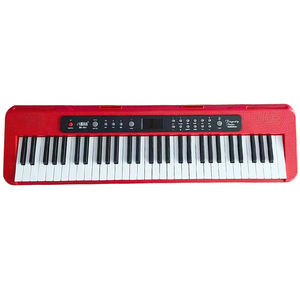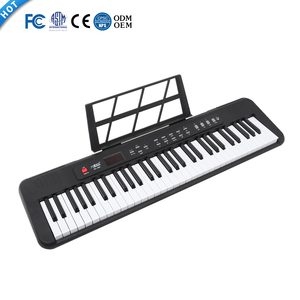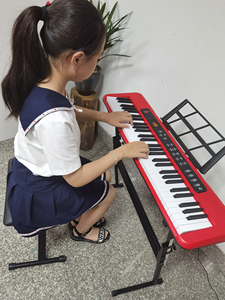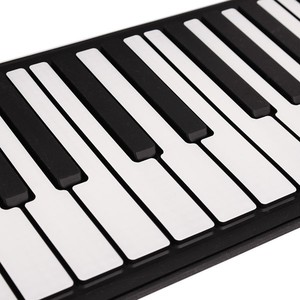
All categories
Featured selections
Trade Assurance
Buyer Central
Help Center
Get the app
Become a supplier

(8087 products available)




















































The Technics organ has several types, which are as follows;
Electromechanical Organs
Electromechanical organs use electrical components and mechanical parts to generate music. Their internal parts include electric motors, generators, and amplifiers. These parts work together to produce sound via the vibrating element. The most popular electromechanical organ is the Hammond organ. It was invented in 1935 and has been used in gospel, jazz, blues, rock, and pop music. Its sound is unique because it uses a harmonic drawbar and a mechanical rotor.
Digital Organs
Digital organs are more advanced than electromechanical ones. They use digital technology and computer systems to create sound. The internal parts of a digital organ include a CPU, memory units, and digital signal processing (DSP) units. Digital organs offer a wider variety of sounds and tonalities than electromechanical ones. They are also more compact and lighter in weight. The Yamaha Clavinova organ is among the best digital organs in the market. It features AWM Dynamic Stereo Sampling technology, which recreates the sound of acoustic pianos. It also has 38 instrument sounds, including pianos, electric pianos, organs, and strings.
Virtual Pipe Organs
Virtual pipe organs are a modified version of the traditional pipe organs. They use advanced digital technology to imitate the sound of real pipe organs. They also require little maintenance compared to traditional pipe organs. The internal components of a virtual pipe organ include a computer, MIDI interface, and speakers. One of the best examples of a virtual pipe organ is the Viscount Organ. It has a wide tonal range and features the latest VPH (Virtual Pipe Technology). These organs also have several presets that allow the user to save different sound configurations.
Hybrid Organs
Hybrid organs combine the features of both digital and electromechanical organs. They use analog circuitry and digital processing to generate sound. Hybrid organs offer a more authentic and richer sound than pure digital organs. They also have more tonal variations than electromechanical organs. The Nord C2D Dual Manual Organ is an example of a hybrid organ. It has two manuals and a wide range of sounds. It also has digital drawbars and a physical rotary speaker control.
Technics organs are versatile musical instruments that find application in various music genres and settings. Here are some typical usage scenarios:
Live Performances
Technics organs are used during the live performances by musicians and bands. They offer a broad range of sounds and styles, which can be used to enhance the music of the following:
Rock
Jazz
Gospel
Funk
Church Services
Technics organs have been used in the church services, as they offer a wide variety of sounds and styles. This can include traditional hymns to contemporary worship music. The digital organ's ability to mimic the sounds of the pipe organ or the electric sounds of the Hammond organ makes it a popular choice for church music.
Recording Studios
Technics organs are used in the recording studios where they add depth and richness to the music. The wide range of sounds and styles available in a single organ makes it a valuable tool for producers and musicians looking to create a unique sound.
Educational Purposes
Technics organs are used in the music schools and colleges. They provide students with a high-quality instrument that is both versatile and easy to use. The organ's many features, such as the accompaniment styles and sound libraries, make it an excellent tool for learning about music production and performance.
Home Entertainment
Technics organs are also used at home by the music lovers. They can play their favorite music and create their own songs. The user-friendly interface and the many features make it easy for anyone to pick up and play.
When buying a Technics organ, one must consider various factors to ensure they get an instrument that suits their needs and preferences. Here are some key points to guide the selection process:
Technics organs come with various features that are designed to enhance the user experience and improve the quality of music. Here are some of the functions, features, and designs of Technics organs.
Sound Library
Technics organ provides a wide range of sounds and tones. This includes traditional organ sounds, piano, strings, synths, and many more. The diverse sound library enables musicians to explore different genres and styles, from classical and jazz to pop and rock.
Digital Sampling
With digital sampling, the organ captures and plays back sounds from different instruments. This makes its sound more realistic and versatile. This feature is especially useful for creating music that requires different instrument sounds.
Reverb and Effects
Digital reverb and effect are used to improve the quality and depth of the sound. These effects help the sound fit into different musical contexts, from spacious concert halls to smaller venues.
Touch Sensitivity
The keys are touch-sensitive, meaning the sound's volume and tone vary according to the player's touch. This feature allows for more expressive and nuanced playing, giving the music a more dynamic range.
Voicing Customization
Voicing Customization allows players to adjust the tone and character of the organ sounds. This feature provides controls for brightness, modulation, and other tonal elements, enabling the player to personalize the sound to suit their playing style.
Automatic Accompaniment
This feature provides pre-set rhythms, chords, and melodies to create a full backing band. With this feature, the organist can play melodies while the organ automatically provides the accompaniment.
Compact and Portable
A compact and portable design makes it easy to transport and store. This is especially useful for musicians who perform at different venues or need to move between practice spaces.
User-Friendly Interface
The organ comes with a simple and easy-to-use control panel and buttons. This makes navigation and adjustments easy for players of all skill levels.
High-Quality Keyboards
The keyboards are designed for durability and playability. It also ensures a comfortable playing experience. Some models even feature weighted keys for a piano-like feel.
Integration with Other Devices
The organs can connect with other devices using MIDI and USB ports. This allows for data transfer, recording, and the ability to connect with computers and other instruments.
Q1. What is the best way to clean the Technics organs?
A1. The best way to clean the Technics organ is to use a soft cloth and a mild soap solution. Then, wipe the keys and the body down. Avoid using harsh chemicals or abrasives, as they can damage the finish. Also, cover the organ with a dust cover when not in use to prevent dust buildup.
Q2. Can users connect the Technics organ to a computer?
A2. Yes, many Technics organs have MIDI ports that allow users to connect the organ to a computer. This connection enables recording, editing, and interaction with music production software. Connecting the organ to a computer also opens up many possibilities for virtual instrument collaboration and expansion.
Q3. What should one do if a specific note on the organ does not play?
A3. If a specific note on the Technics organ does not play, check if the key is stuck or obstructed. If not, there may be an issue with the organ's internal electronics or a faulty contact point. In this case, one will need to contact a qualified technician for repair.
Q4. How can users maintain the organ's sound quality over time?
A4. To maintain the organ's sound quality over time, keep it clean and free of dust and debris. Also, ensure the organ is kept in a climate-controlled environment to prevent damage from extreme temperatures or humidity. Regularly checking and replacing any worn or damaged parts will also help maintain the sound quality.
Q5. Is it possible to record music directly from the Technics organ?
A5. Yes, many Technics organs have a built-in recording feature that allows users to record music directly from the organ. Some models also have audio outputs, enabling the recorded music to be sent to an external recording device or computer. This feature is great for sharing music or creating demo recordings.